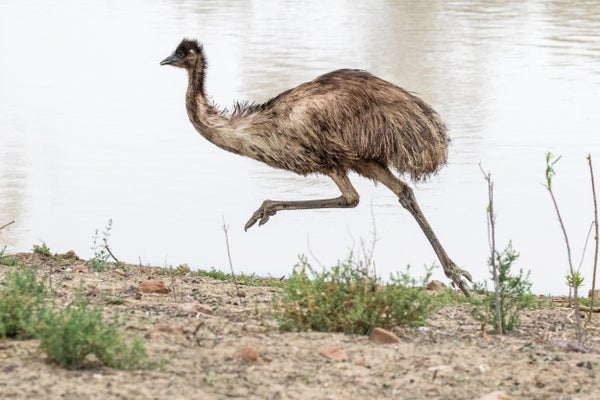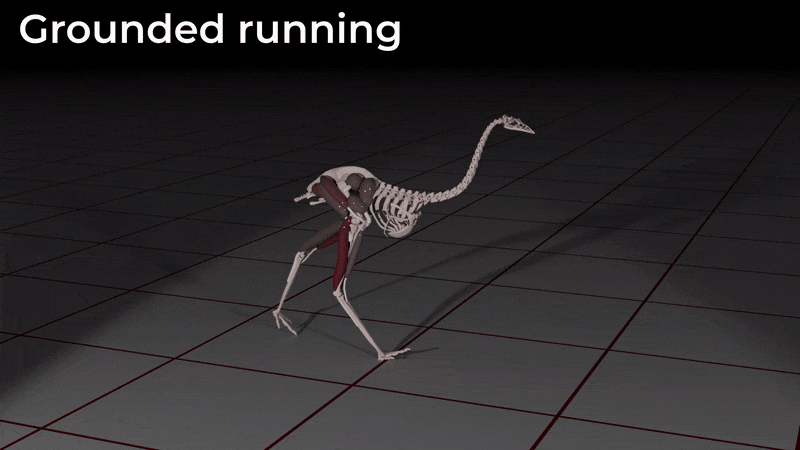September 25, 2024
3 min read
Here’s Why Birds Look So Goofy When They Run
Looking silly when they run saves birds energy—and some dinosaurs may have done the same

Ken Griffiths/Alamy Stock Photo
When humans want to move fast—barring speed-walking competitions—we pick up our feet. But when birds need to get somewhere quickly, they tend to always keep one foot on the ground, leading to a strange-looking gait that scientists call “grounded running.”
“Most people won’t even probably realize that they’ve seen a bird use grounded running,” says Pasha van Bijlert, a Ph.D. candidate in evolutionary biomechanics at Utrecht University and Naturalis Biodiversity Center in the Netherlands. “Some of the times that you see a bird walking in a weird way, they’re actually not walking; they’re running—you can tell from the fact that they’re bouncing.”
Grounded running in birds has puzzled scientists because humans mimicking the behavior use quite a bit more energy to travel at the same pace than we do with our habitual style of running, called aerial running. But research published on September 25 in the journal Science Advances by van Bijlert and his colleagues finds that birds aren’t foolish, even if they may look silly during grounded running.
On supporting science journalism
If you’re enjoying this article, consider supporting our award-winning journalism by subscribing. By purchasing a subscription you are helping to ensure the future of impactful stories about the discoveries and ideas shaping our world today.
The new study uses a computer model of a Common Emu (Dromaius novaehollandiae) to show that the birds’ posture makes grounded running more efficient than aerial running at certain speeds. Researchers built the model because they expected two factors to influence the birds’ movement: their highly elastic leg tendons and their crouched stance, with hips and knees tucked into their feathered body.

A virtual model of an emu used to study bird locomotion.
Neither factor lends itself to physical experiments. “You can’t really change a bird’s anatomy and see how that affects its running styles,” van Bijlert says. “I can’t train an emu to stand up straight.” Hence the simulation approach, which allowed the researchers to adjust emus’ leg anatomy and prevent the tendons from storing energy as they tested what gaits were most efficient for moving at certain speeds.
The simulation alone is impressive work, says Armita Manafzadeh, a biomechanist at Yale University, who was not involved in the new research. “Physics-based simulations with locomotion has come such a long way,” she says. “When this kind of methodology first started out, there were so many simplifications being made and the algorithms were so simplistic that the outputs on the computer really didn’t look like a living animal at all.”
The simulations showed two strategies for reducing energy expenditure while moving fast: starting from a straight-legged standing position or keeping one foot on the ground as much as possible. Humans take the first route, but birds can’t—so they use grounded running instead. (Humans asked to run in a crouched position will instinctively switch to grounded running as well, if you’d like to give it a try.)
“If we think about bird locomotion through a human lens, then [grounded running] seems like a really weird and kind of dumb thing to do because it seems really energetically costly,” Manafzadeh says. “It’s actually a pretty smart thing to do when you have the anatomy of a bird.”
Learning more about emus is all well and good, but van Bijlert hopes that the research can also inform scientists’ understanding of birds’ long-lost ancestors, dinosaurs. He suspects that in particular, dinosaurs that are closer relatives of birds, such as the petite velociraptors, may have chased down their prey like a nightmare agent of the Ministry of Silly Walks.
But he’ll need to do more simulations to determine whether bipedal dinosaurs, including the fearsome Tyrannosaurus rex, may have also practiced grounded running, Manafzadeh says.
Dinosaurs aside, she hopes that the new research reminds scientists to be curious about how other species are experiencing life on Earth. “If we try to interpret the diversity of animal locomotion through a human-centric lens,” Manafzadeh says, “we’re going to miss out on lots of really cool and equally viable ways of moving around the world.”


































